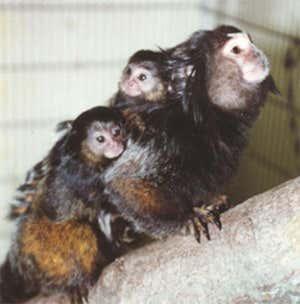
Chimera
n., plural: chimeras
[kaɪˈmɪərə; kɪ-]
Definition: any organism with a mix of cells with different genes
Table of Contents
When we learned about the basic genetics of biological life, we came to know that almost all the cells of an individual have the same genotype. Based on the different tissue or organ system that a cell becomes part of, the expression of different genes varies. The neuronal cell will highly express the gene for voltage-gated ion channels while the ocular (eyes) cell will highly express the gene coding for rhodopsin protein. In a similar way, even though the genetic makeup of all the cells in the different parts of your body is the same, the way it expresses is different in humongous ways. Now, if we tell you that in some rare cases, the genotype of different cells of your body can be “different” too, would you believe it? Yes, you have to believe it as this is a natural phenomenon known as “CHIMERISM” … Read on to learn more about what is the meaning of chimera, can it occur in real organisms, how do we define chimera in biology, how do we explain the concept of chimera in genetics, and how common or rare is a human chimera?
Chimera Definition
Chimerism is defined as a ‘phenomenon of occurrence of more than one type of different and distinguished genotype in an organism’. This phenomenon, although a rare sight, can be seen in different kingdoms of life — plants, animals, bacteria, and fungi. Moving ahead, the question arises: what is a chimera? So, we define a chimera as “an organism composed of cells with different genotypes altogether.” There’s no such difference in the definition of chimera in Biology, Medical and Genetics perspective. (Biological, Medical, and Genetic definitions of chimera are all defined in the same way). While chimerism is a phenomenon, a chimera is an organism. The plural of “chimera” is chimeras.
A chimera is an organism that possesses genetically distinct types of cells. Chimerism (the condition) can be formed by the fusion of two early blastula stage embryos or by the reconstitution of the bone marrow in an irradiated recipient or by somatic segregation.Etymology: from Latin “chimaera”, from Greek “khimaira”, meaning “female goat”.
Variant: chimaera.
Animals
The concept of chimerism isn’t foreign to the Animal Kingdom. A chimeric animal is one that possesses 2 or more different sets of genotypes in its cells. This genotypic difference within the same organism can result from many different situations like:
- “Coming together of 2 or more zygotes in a single reproduction event”: This means that during fertilization, many eggs get fertilized here, and then all the fertilized eggs fuse to form one individual.
- “Via organ transplantation”: This means that one donor individual’s genotype is introduced in the body of the receiver. This results in an animal with two different genotypes in different cells (foreign/donated organ cells and self-cells).
This is a rare event leading to very characteristic features like:
- An individual animal with chimerism symptoms like different blood type-denoting blood cells. (Normally, all blood cells in an individual have the same genotype!)
- An individual chimera animal with different phenotypes. (Because of different genotypes!)
- A DNA chimera in an animal resulting from the unity of 2 zygotes of differing, opposite sexes. This results in an organism where the presence of both male and female reproductive organs can be seen. This is an example where chimerism can cause intersexuality (a case of hermaphroditism).
NOTE: Difference between Chimera and Mosaic — people often confuse these two terms. Look at the table to understand the difference.
Table 1: Difference between chimera-vs-mosaic | ||
|---|---|---|
| Feature | Chimera | Mosaic |
| Sources of different cells/cell populations | Two different zygotes | One zygote only |
| Reason for chimera/mosaic formation | Fusion of two or more different fertilized eggs | Somatic mutation in the early developmental phase of the zygote |
| Ease of identification | Such organisms are difficult to identify or report as there are both normal and abnormal (additional) copies of genes. *Only in cases of chimerism with a sex chromosome constitution, it is easier to report and identify the phenomenon.* REASON: Distinct sex organs (both male and female would be present) | Such organisms are frequently reported with chromosomal abnormalities. Examples: trisomy, monosomy, triploidy, and other chromosomal aberrations. |
| Significance | One of the reasons for intersexuality. | Mosaicism is useful in the determination of the genetic basis of diseases. |
Data Source: Akanksha Saxena of Biology Online
Tetragametic chimerism
Tetragametic chimerism is a type of chimerism that manifests during the time of embryo development. It involves four different parental lines — two maternal and two paternal. As two fertilized zygotes are formed at the end of two separate fertilization events in this process, they fuse to form one “aggregate zygote”.
- Resultant organism: Possession of intermingled cell lines
- Commonly reported in Marmosets (Callithrix kuhlii), male tortoiseshell cats and calico cats
- Implications: This tetragametic chimera state is strategic for organ or stem cell transplantations. (Reason: As chimeras possess immunologic tolerance to types of cell lines)


Microchimerism
Microchimerism is the phenomenon where “only a tiny constitution” of the host individual’s genetic makeup is genetically different. There are various speculations about microchimerism’s association with the predisposition of autoimmune diseases in individuals.
Plausible reasons for Microchimerism:
- Bidirectional transfer of genetic material/cells between mother and her baby (fetus) during pregnancy
- Twin-to-twin transfer in mother’s uterus
- Transfer from organ transplantation
- Transfer from a blood transfusion

Symbiotic chimerism in anglerfish
Symbiotic chimerism is a mind-blowing phenomenon in nature. In this, a male anglerfish after reaching sexual maturity goes and fuses with the female anglerfish to live together in symbiosis. The female counterpart is referred to as the host symbiont and the male counterpart is only referred to as symbiont in this relationship. This is an essential process for an anglerfish to complete its life cycle.

Germline chimerism
Germline chimerism is the phenomenon of the availability of “genetically distinct germ cells” in an individual organism. Normally, all germ cells in an organism are supposed to be of identical genetic make-up. But in germline chimerism, it’s not the case.
Example: Marmosets have been reported to carry genetically distinct germ cells from their fraternal twin siblings. (Reason: There is a well-established fusion of placenta)

Artificial chimerism
Artificial chimerism encompasses the occurrence of a chimera where one set of genotypes has been “artificially introduced” in the organism’s body. Probable methods of artificial introduction of genetic material (genotype) distinct from the organism’s self-genetic material: Transplantation
Example: Quail-chick chimeras are genetic chimeras.
 |  |  |
| Figure 6: Quail-chick chimera is an example of an artificial chimera. Image Credit: sdbonline.org. | ||
Humans
Chimerism in humans isn’t rare. Although we have always thought it to be an extremely rare event as we are incapable of distinguishing and making out a human chimera. (Reason: as many small phenotypic changes are very subtle, for example- a slight difference in eye color, skin pigmentation, etc.)
Only when the sex chromosomes are involved, the identification of chimera becomes easier in humans. It’s not impossible that in a chimeric human being, some organ is made up of cells from one origin. For example, liver cells possessing the first set of chromosomes) and simultaneously some other organ is made up of cells from an entirely different origin (for example, kidney cells possessing the second set of chromosomes).
- Human Chimera (Definition): A human being with two or more different sets of DNA.
NOTE: There are laws across all the countries in the world to ban any advance in research efforts to design “human-animal chimeras”. Reason: As science advances far and wide, the thin line of ethics shouldn’t be crossed and absolutely no attempts should be made in this direction. No plans should be designed to make human chimera babies. Another rationale behind this law is that- as soon as you try to bridge the distance between animals and humans by designing a chimera of both, you invite “deadly zoonotic viruses in the human health system”. And we shouldn’t forget how dangerous a zoonotic virus can be, look at the Covid-19 pandemic! (SAR-CoV-2 too is a zoonotic virus!)

Hermaphrodites
No such case of human chimera has been reported to date where hermaphroditism has led to self-fertilization.
Bone marrow recipients
For bone marrow recipients, a number of unusual chimerism phenomena cases have been reported.
Chimera identification
- Most of the chimerism cases aren’t reported as we are not aware or equipped enough to identify the subtle changes in the phenotypes upon chimerism.
- Rare cases of easy detection: Only in cases where chimerism is involved with the sex organs, we are easily able to identify chimeras.
- Chimerism human symptoms or signs: None as such in humans.
- Physical distinction signs: Different color of eyes, hyper-pigmentation, hypo-pigmentation.
- Usual discovery of chimeric condition in humans: During a forensic investigation or while getting a maternity/paternity test done.
Research
The research in this field is driven by curiosity. Scientists have tried making chimeras in so many animals. Some of those are:
- Rhesus monkey (Roku and Hex)
- Sheep–goat chimera
- Quail-chick chimera
- Human chimeric embryos (with 15% human skin cells and 85% rabbit ovum)

Sponges
- Sponges chimera reported till date: In marine sponges.
- Maximum different genotypes reported in a single representative of the species: 4
- Scope: High scope for more genotypes and hence more heterogeneity

Mice
Mice have been exploited as models for several research questions related to human beings. Hence, the concept of mice chimera is an important one that provides room for the investigation of the science of chimerism and the existence of two distinct genetic pools in a single organism.

Underlying biology
Knowing the developmental biology of organisms becomes integral when talking about chimera and the science behind it.
Post-fertilization of the mouse egg by the mouse sperm, a zygote is formed. Before this zygote traverses the distance and gets implanted in the mother’s uterus, there’s scope for many different cell lineages’ formations. These different developmental stages are exploited to develop different types of mice chimeras.
Methods of production
Depending on the goal of the experiment and the picture of chimera in our mind, we can pick the developing zygote at different stages (from zygote to embryo to blastocyst). A common way of designing a chimeric mouse is by a combination of embryonic stem cells (ESC) and diploid embryos (DE).
Plants
Chimeras are common in the Plant Kingdom too.
- The characteristic feature of plant chimeras: Different types of tissue can easily originate from the same zygote.
- Reason for the distinction in the different tissues: Occurrence of “mutational process” during ordinary cell divisions.
- Identification of chimerism: Just like the animal world and humans, it’s not easy and not visible on a casual investigation.
- Way to identify chimerism in plants: Genetic testing to prove parentage




Structure
We exploit the difference between 3 types of plant chimera:
- Sectorial plant chimeras
- Mericlinal plant chimeras
- Periclinal plant chimeras

Graft chimeras
Grafting is a common technique in the propagation of plant lines. We can make graft chimeras by grafting distinct parents, cultivars or species (genetically different). The grafted individual or chimera now possesses both types of tissue. The first known graft chimera is “Bizzaria” (a fusion product of Florentine citron and the sour orange).

Chromosomal chimeras
Chromosomal chimeras signify different layers of plants with different chromosomal constitutions. Only occasionally, some of the chromosomal chimeras will arise following either the loss or gain of some chromosomal fragments or an entire individual chromosome. This happens because of “misdivision”. This way of chimerism affects cell sizes and cell growth features.
Nuclear gene-differential chimeras
Nuclear gene-differential chimeras are the ones that arise when a spontaneous mutation or an induced mutation happens in one or more nuclear genes.
Plastid gene-differential chimeras
Plastid gene-differential chimeras are the ones that arise when a spontaneous mutation or an induced mutation happens in one or more plastidial genes. This is immediately followed by vegetative growth. Vegetative growth is accompanied by the separation of the two kinds of plastids.
Origins
The origin of plant chimerism arose many years back. The first known record is of a graft chimera between sour orange (Citrus aurantium) and citron (Citrus medica).
Detection
Detection methods for plant chimeras:
- Reporter gene GUS
- Reporter gene Green Fluorescent Protein (GFP)
- Quantitative PCR
Viruses
Some reported virus chimeras:
- BSL-RDHV (Boiling Spring Lake RNA DNA Hybrid Virus): A RNA-DNA hybrid virus.
- CHIV virus (chimera virus)
Try to answer the quiz below to check what you have learned so far about chimera.
References
Ross, C. N.; J. A. French; G. Orti (2007). “Germ-line chimerism and paternal care in marmosets (Callithrix kuhlii)”. Proceedings of the National Academy of Sciences. 104 (15): 6278–6282. Bibcode:2007PNAS..104.6278R. doi:10.1073/pnas.0607426104
Maureen A. Knippen, “Microchimerism: Sharing Genes in Illness and in Health”, International Scholarly Research Notices, vol. 2011, Article ID 893819, 4 pages, 2011. https://doi.org/10.5402/2011/893819
Boddy, A. M., Fortunato, A., Wilson Sayres, M., & Aktipis, A. (2015). Fetal microchimerism and maternal health: a review and evolutionary analysis of cooperation and conflict beyond the womb. BioEssays : news and reviews in molecular, cellular and developmental biology, 37(10), 1106–1118. https://doi.org/10.1002/bies.201500059
Froese, Rainer, and Daniel Pauly, eds. (2006). “Ceratiidae” in FishBase. February 2006 version.
Manus M. Patten (2021). On Being a Monkey’s Uncle: Germline Chimerism in the Callitrichinae and the Evolution of Sibling Rivalry. The American Naturalist 2021 197:4, 502-508
Agrawal, S. J., & Lwigale, P. Y. (2015). Quail-chick chimeras and eye development. Methods in molecular biology (Clifton, N.J.), 1189, 255–263. https://doi.org/10.1007/978-1-4939-1164-6_17
Marie Gauthier, Bernard M. Degnan. (2008). Partitioning of genetically distinct cell populations in chimeric juveniles of the sponge Amphimedon queenslandica, Developmental & Comparative Immunology, Volume 32, Issue 11, Pages 1270-1280, ISSN 0145-305X, https://doi.org/10.1016/j.dci.2008.04.002.
©BiologyOnline.com. Content provided and moderated by Biology Online Editors.








